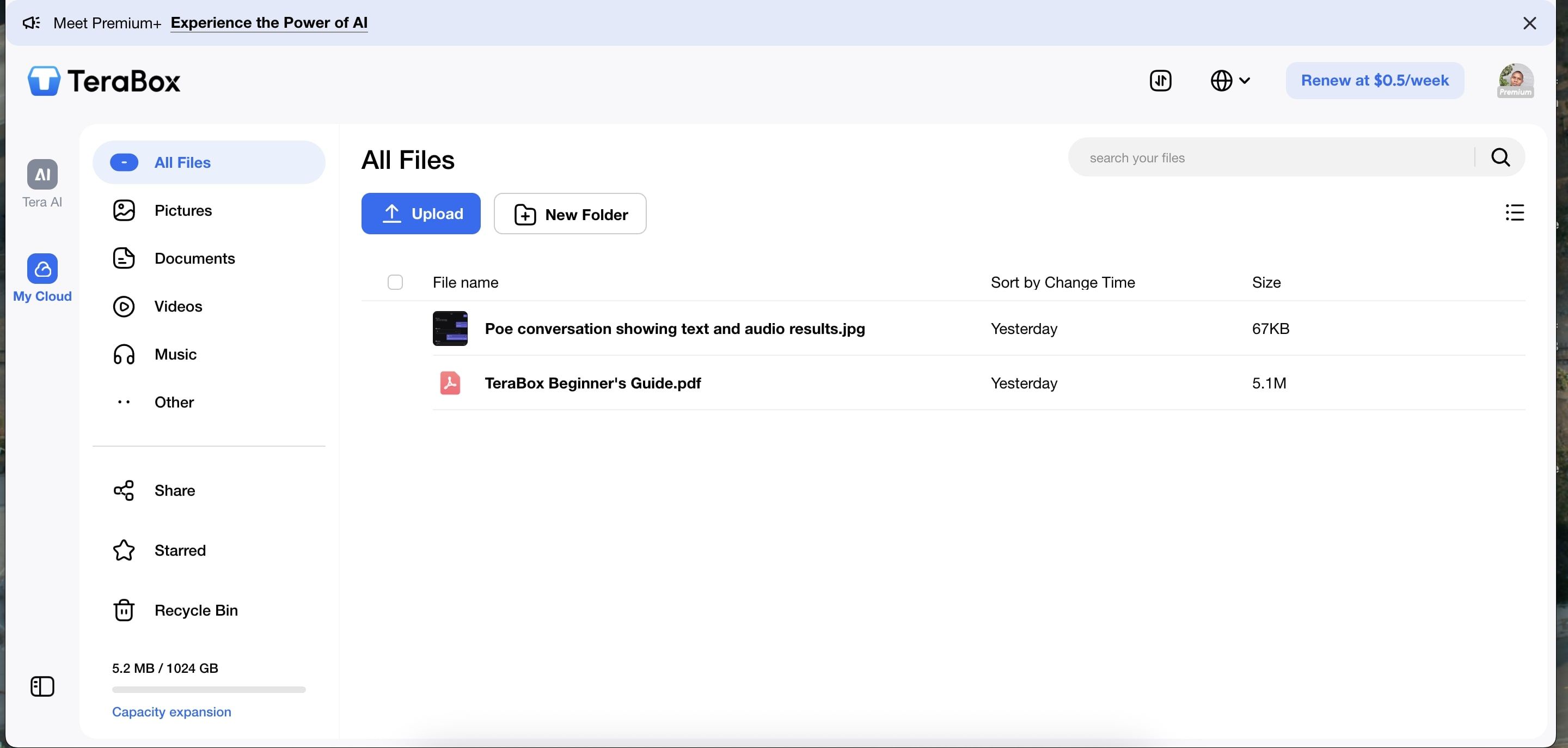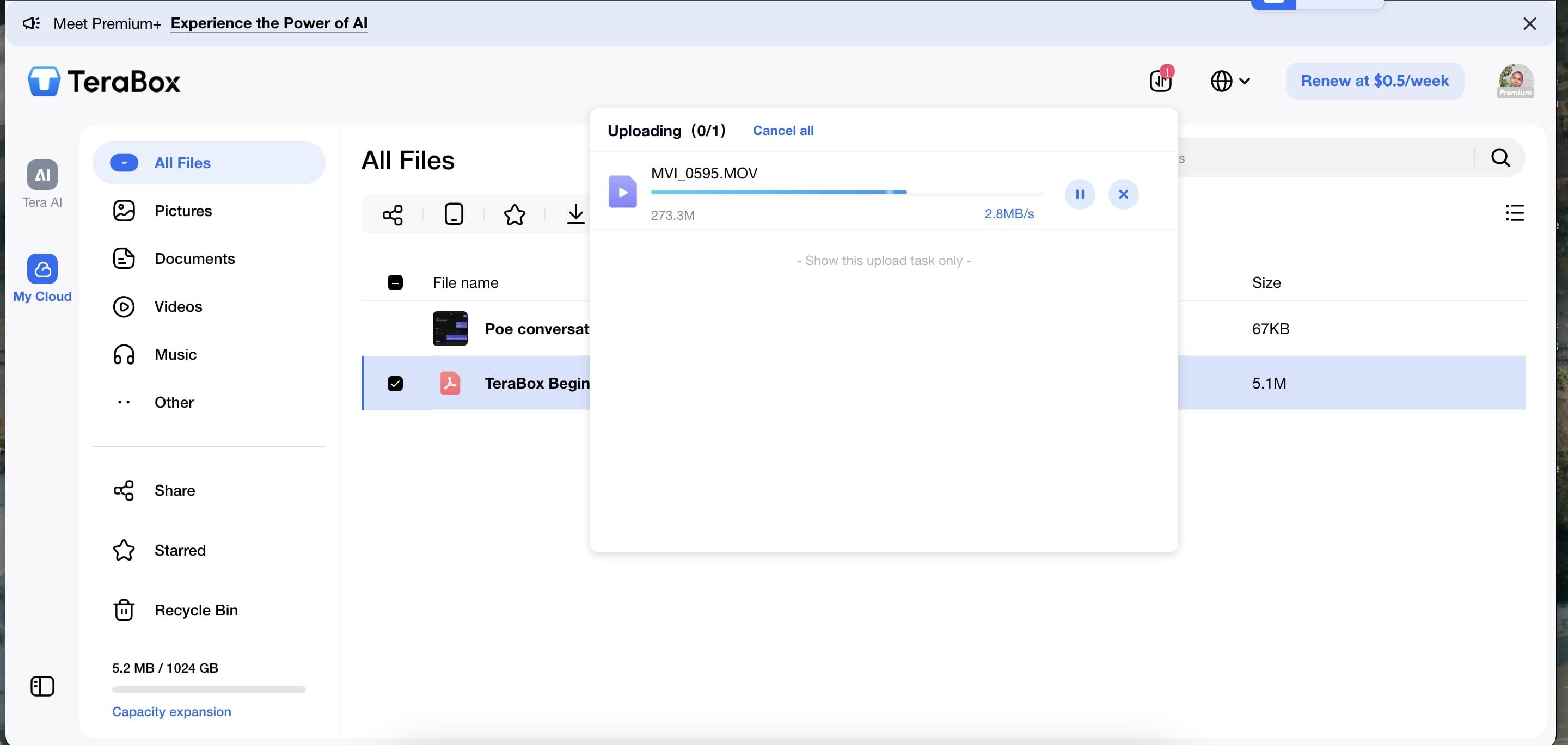TeraBox stands out for its generous free plan: one terabyte at no cost. But the convenience ends there. That free terabyte of storage is a wonderful idea, but the experience required to access it asks more from you than you might be willing to give.
TeraBox Is Generous With Space, but Tricky to Use
TeraBox gives you more free storage than most cloud services. One terabyte is enough for thousands of photos, hundreds of videos, or large archives of documents. That kind of space, at no cost, is hard to ignore.
But the experience of actually using it comes with restrictions that are hard to overlook.
The TeraBox mobile app displays ads every time you open it. These aren’t small banners at the bottom of the screen; they take over the entire interface and delay access to your files. You can remove the ads, but only by paying for a premium subscription.

Related
This Is the Best Free Cloud Storage—I Can’t Believe More People Aren’t Using It
The free cloud storage arms race has a quiet winner.
There’s also a more significant limitation. If you’re using the mobile app, you can’t upload video files unless you have a paid account. You can still upload photos, documents, and other formats, but videos are blocked for free users. The app doesn’t make this restriction obvious. You only discover it when you try to upload a video and see that the option is disabled.
If you’re someone who keeps app notifications turned on, the app experience gets even worse. The app sends incessant notifications all day, prompting you to upgrade to its paid plan.
The desktop and browser versions offer a significantly better experience overall. The web interface offers familiar drag-and-drop support for file uploads and a clear, visual representation of your data and remaining storage. More importantly, the video upload restriction that plagues mobile users doesn’t exist in the browser version. You can upload videos of any supported format without needing a premium account. While ads are still present, they’re far less intrusive and don’t block your workflow like they do on mobile.
However, the desktop apps are essentially a mirror image of the web version, lacking dedicated sync folders or automated backup capabilities. This means you can’t set up automatic folder syncing like you would with Google Drive or Dropbox, making it less useful for seamless file management across devices.
Workarounds Exist, but They’re Not for Everyone
If you’re set on using TeraBox without paying, there are ways to work around some of the app’s limitations.
One method is to avoid the mobile app entirely. If you’re using a phone or tablet, access TeraBox through a web browser and request the desktop version of the site. This bypasses the video upload restriction and avoids the full-screen ads.
Another workaround is to compress video files into ZIP archives before uploading. TeraBox allows free users to upload compressed files, even if they contain videos. This extra step isn’t convenient, but it lets you store media without upgrading to premium.
From experience, upload speeds are fairly solid. Speeds go up to 10 Mbps when uploading a single file. Download speeds were slower (about 1 Mbps) but manageable for personal use.
However, users often report occasional hiccups with reliability. The site sometimes loads slowly, especially on mobile browsers, and large uploads can fail without clear error messages. It’s not uncommon to find yourself restarting the same upload multiple times, especially with folders or larger files.
Those small headaches add up. And they’re part of why I find it hard to recommend TeraBox to anyone who doesn’t have the patience to babysit their uploads.
TeraBox Probably Shouldn’t Be Your Only Cloud Backup
TeraBox gives you a lot of storage for free, but there’s no guarantee it will stay that way. Free services can change their policies at any time, and there’s not much users can do when that happens.
For example, in 2025, Yahoo Mail revealed it was cutting its free storage from 1TB to 20GB. Users who don’t upgrade or clear space fast enough would be blocked from sending or receiving emails. This is a reminder that generous offers can disappear without much warning.
TeraBox hasn’t announced any such reductions yet, but the risk is always there. The service doesn’t share much detail about how it plans to sustain the free plan over time or exactly how it’s funded. Some of the revenue comes from ads and premium upgrades, but the bigger picture isn’t clear.
Then there’s the privacy side. Like most cloud providers, TeraBox’s policy says it can share certain information with third parties, including local governments or other authorities, in situations involving threats to life, property, or public health. On its own, that isn’t unusual. However, when you combine that with vague ownership details and limited transparency about where your files reside, it can feel more challenging to rely on it as your sole backup.
Is All That Space Really Worth the Hassle?
A full terabyte sounds like a dream come true, but TeraBox makes you work for every gigabyte.
Its premium plan unlocks some obvious improvements. You get video uploads on mobile, fewer ads, and faster downloads. However, it’s hard to ignore how many of those features feel like fixes for the issues that free users encounter from the start. If the base experience is frustrating, it doesn’t exactly build trust in what the upgrade will offer.
For what it is, TeraBox can still be a useful tool. It might not be your primary cloud provider, but it can serve as extra storage for large files you don’t use often, or as a place to keep an additional copy of folders that are already backed up elsewhere.

Related
This Is the Best Free Cloud Storage—I Can’t Believe More People Aren’t Using It
The free cloud storage arms race has a quiet winner.
Alternative free cloud services, such as MEGA, Icedrive, and pCloud, offer different trade-offs. They may provide less free space, but some users prefer their simplicity or clearer privacy policies. It really depends on what you’re looking for: raw storage, usability, or peace of mind.
In the end, one terabyte for free is impressive. Whether or not it’s worth the effort depends on how much you’re willing to put up with along the way.

